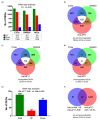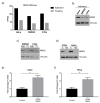Spontaneous Cell Detachment and Reattachment in Cancer Cell Lines: An In Vitro Model of Metastasis and Malignancy
- PMID: 34066490
- PMCID: PMC8124513
- DOI: 10.3390/ijms22094929
Spontaneous Cell Detachment and Reattachment in Cancer Cell Lines: An In Vitro Model of Metastasis and Malignancy
Abstract
There is an unmet need for simplified in vitro models of malignancy and metastasis that facilitate fast, affordable and scalable gene and compound analysis. "Adherent" cancer cell lines frequently release "free-floating" cells into suspension that are viable and can reattach. This, in a simplistic way, mimics the metastatic process. We compared the gene expression profiles of naturally co-existing populations of floating and adherent cells in SW620 (colon), C33a (cervix) and HeLa (cervix) cancer cells. We found that 1227, 1367 and 1333 genes were at least 2-fold differentially expressed in the respective cell lines, of which 122 were shared among the three cell lines. As proof of principle, we focused on the anti-metastatic gene NM23-H1, which was downregulated both at the RNA and protein level in the floating cell populations of all three cell lines. Knockdown of NM23-H1 significantly increased the number of floating (and viable) cells, whereas overexpression of NM23-H1 significantly reduced the proportion of floating cells. Other potential regulators of these cellular states were identified through pathway analysis, including hypoxia, mTOR (mechanistic target of rapamycin), cell adhesion and cell polarity signal transduction pathways. Hypoxia, a condition linked to malignancy and metastasis, reduced NM23-H1 expression and significantly increased the number of free-floating cells. Inhibition of mTOR or Rho-associated protein kinase (ROCK) significantly increased cell death specifically in the floating and not the adherent cell population. In conclusion, our study suggests that dynamic subpopulations of free-floating and adherent cells is a useful model to screen and identify genes, drugs and pathways that regulate the process of cancer metastasis, such as cell detachment and anoikis.
Keywords: NM23; anoikis; cell detachment; cell reattachment; floating cells; mTOR; metastasis models; suspension cells.
Conflict of interest statement
The authors declare no conflict of interest. The funders had no role in the design of the study; in the collection, analyses, or interpretation of data; in the writing of the manuscript, or in the decision to publish the results.
Figures






Similar articles
-
Nm23-H1 gene as a molecular switch between the free-floating and adherent states of gastric cancer cells.Cancer Lett. 2001 Dec 10;174(1):65-71. doi: 10.1016/s0304-3835(01)00684-x. Cancer Lett. 2001. PMID: 11675153
-
Characterization of the metastatic potential of the floating cell component of MIA PaCa-2, a human pancreatic cancer cell line.Biochem Biophys Res Commun. 2020 Feb 19;522(4):881-888. doi: 10.1016/j.bbrc.2019.11.120. Epub 2019 Dec 2. Biochem Biophys Res Commun. 2020. PMID: 31806369
-
ROCK inhibition promotes microtentacles that enhance reattachment of breast cancer cells.Oncotarget. 2015 Mar 20;6(8):6251-66. doi: 10.18632/oncotarget.3360. Oncotarget. 2015. PMID: 25749040 Free PMC article.
-
The multiple regulation of metastasis suppressor NM23-H1 in cancer.Life Sci. 2021 Mar 1;268:118995. doi: 10.1016/j.lfs.2020.118995. Epub 2021 Jan 6. Life Sci. 2021. PMID: 33421524 Review.
-
[NM23, an example of a metastasis suppressor gene].Bull Cancer. 2012 Apr 1;99(4):431-40. doi: 10.1684/bdc.2012.1550. Bull Cancer. 2012. PMID: 22429909 Review. French.
Cited by
-
Kinetics of Cellular Cobalamin Uptake and Conversion: Comparison of Aquo/Hydroxocobalamin to Cyanocobalamin.Nutrients. 2024 Jan 27;16(3):378. doi: 10.3390/nu16030378. Nutrients. 2024. PMID: 38337663 Free PMC article.
-
Spontaneous Cell Detachment from Temperature Gradients: Getting the Method Ready for Antimicrobial Drug Testing at Cell Culture Level.Sensors (Basel). 2025 May 4;25(9):2902. doi: 10.3390/s25092902. Sensors (Basel). 2025. PMID: 40363339 Free PMC article.
-
Mitochondrial division inhibitor (mdivi-1) induces extracellular matrix (ECM)-detachment of viable breast cancer cells by a DRP1-independent mechanism.Sci Rep. 2024 Jun 19;14(1):14178. doi: 10.1038/s41598-024-64228-9. Sci Rep. 2024. PMID: 38898058 Free PMC article.
-
NSUN6 Regulates NM23-H1 Expression in an m5C Manner to Affect Epithelial-Mesenchymal Transition in Lung Cancer.Med Princ Pract. 2024;33(1):56-65. doi: 10.1159/000535479. Epub 2023 Nov 29. Med Princ Pract. 2024. PMID: 38029727 Free PMC article.
References
MeSH terms
Substances
Grants and funding
LinkOut - more resources
Full Text Sources
Medical
Research Materials
Miscellaneous

